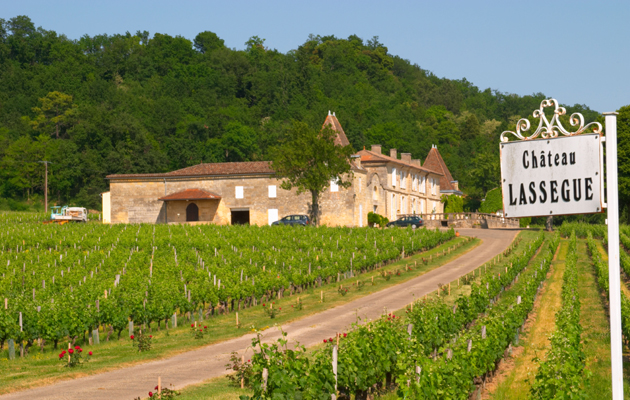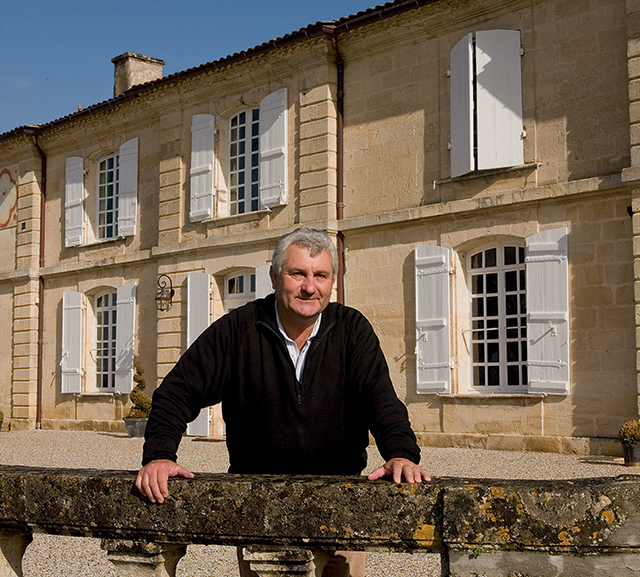Bringing in the Bordeaux
Expert vigneron Pierre Seillan explains why this year's wine is set to be one of the best.


It is an unseasonably cold late-spring morning in Saint-Émilion, France, and Pierre Seillan is enjoying a rare day off on his 84-acre estate, Château Lassègue. His furrowed brow adds to the impression of a man who, even when he isn’t officially working, still has 1,001 things to sort out. ‘I’m not a very patient man,’ he admits. ‘We’re on our way to improving the winemaking here, changing the style of the farming, paying closer attention to details in the vineyard, remodelling the buildings. Life moves fast and there’s a lot to be done.’
This morning, he was up before 6am, same as every day and, some nights, he’s still thinking about his vines at 2am. It’s a hard life, a long way removed from the sometimes glossy image of M. Seillan to be found in the pages of the international wine press, where he’s known as a world-class vigneron, a man who can glance at a row of quietly ageing barrels and work out the perfect mix.
At heart, however, M. Seillan is a farmer, and the intentionally low yield he squeezes out of his crop remains as with wheat or corn the product of earth and weather. ‘I am basically a servant of the soil,’ he says with a throaty chuckle. ‘Oenology can only make a correction of the original. For me, it’s all about the soil.’
The vineyards of Saint-Émilion form one of the more lovely parts of Bordeaux, which comprises some 50 distinct appellations that are legally allowed to bear the Bordeaux name. A collection of relatively small wine-growing estates radiating from Saint-Émilion itself, the area is also home to some of the world’s most acclaimed wines and, naturally, M. Seillan has an eye on being among them.

He certainly has the credentials, but has only been at the helm of this particular estate for 10 years, having bought it in partnership with his good friend Jess Jackson, the late co-founder of Jackson Family Wines, whose wife, Barbara Banke, now heads one of California’s most important wine-growing families. ‘I visited Château Lassègue just twice before I invited my family and Jess’s to come and see it,’ says M. Seillan, who has been joined by two generations of both families in the business. ‘We all agreed that it was perfect for what we wanted and that we had to buy it.’
Pointing to a small but important hill on the estate, which gives his vines a magnificent southerly aspect and affords full sunlight from dawn until dusk, he explains why they snapped up the vineyard. ‘In addition to the hill, there was the soil. It’s beautiful stuff and there are nine different types across the 84 acres.’ The icing on the cake was the age of the vines themselves, all about 50 years old and with deep roots tapping into some of the soil’s most treasured nutrients. ‘My mission has always been to capture the message of the soil.’
Whenever he’s scoping out a new vineyard and he’s worked at many one of the things M. Seillan most likes to do is to tear up a clump of grass and smell it. He does the same to the leaves on any trees. ‘I’m not trying to discover their flavour I’m trying to assess the intensity of their aroma and it’s a fantastic way to gather information. It pays to have a dash of the Native American about you.’
Exquisite houses, the beauty of Nature, and how to get the most from your life, straight to your inbox.
Born and raised not far from Saint-Émilion in a farming family, M. Seillan has been working in vineyards since he was 16. At Château Las-sègue, a typical day is determined by the weather. It involves admin, regular communication with the small team who work on the estate, an eagle-eyed look to check the pruning of his vines, usually a barrel tasting and then, as his colleagues head home for the night, a new burst of acti-vity as his associates in California wake up.
M. Seillan’s long-standing relationship with the Jackson family means he’s also heavily involved in several of their estates, from Tuscany to California, including the prestigious Vérité, which recently chalked up an historic Sonoma County first when seven of the vineyard’s wines were awarded the maximum 100 points by the industry’s leading critic Robert Parker Jr.
The Jackson family and M. Seillan seem a match made in wine heaven, as the former’s commitment to long-term sustainability of the land and their passion for making wines that are individual expressions of their terroir are in tune with M. Seillan’s own philosophy. He sees vineyards not as single entities, but as multiple individual parcels of land and expands on the idea while drawing in pen on the back of an envelope.
‘This area here,’ he says, making a rough circle, ‘let’s say it’s 10 acres of Merlot grapes. I look at the land and see a slope here and know that there will be perhaps six or seven different types of soil. The first thing I do is flag where their borders are.’ He calls this approach ‘micro cru’. ‘This parcel will go into one tank. This lot another. I separate, instead of taking one big 10-acre block and mixing it all together. They ferment in different small tanks and then I put them in different barrels and each will have a different flavour.’
When I next catch up with M. Seillan, he’s in a good position to assess what a less-than-sparkling summer has done to his 2014 crop and is in a philosophical mood. ‘It is a surprising vintage. Blooming started in June and was fast and even a good sign and then July and August were humid, rather than warm. Around August 15 in Bordeaux, we were all nervous.’ With limited options available, he decided to concentrate on canopy management: manipulating the visible vine (as opposed to its roots) with techniques such as leaf pulling in order to make the most of the challenging weather.
‘Then, at the end of August, a miracle happened. The weather changed, summer finally arrived and we had good temperatures throughout September.’
When he started pulling the grapes off the vines on September 29, the fruit was ‘superb’ and, although it will be 2016 before this summer’s wine reaches the bottle, M. Seillan is already quietly toasting its success. ‘After 48 vintages, this is probably one of the best I’ve ever had,’ he says. ‘It was a reminder that a great vintage really starts in the vineyard and it’s proof that, even after all these years, there’s still a lot to learn.’
For information, visit www.chateau-lassegue.com and www.jacksonfamilywines.com
Country Life is unlike any other magazine: the only glossy weekly on the newsstand and the only magazine that has been guest-edited by His Majesty The King not once, but twice. It is a celebration of modern rural life and all its diverse joys and pleasures — that was first published in Queen Victoria's Diamond Jubilee year. Our eclectic mixture of witty and informative content — from the most up-to-date property news and commentary and a coveted glimpse inside some of the UK's best houses and gardens, to gardening, the arts and interior design, written by experts in their field — still cannot be found in print or online, anywhere else.
